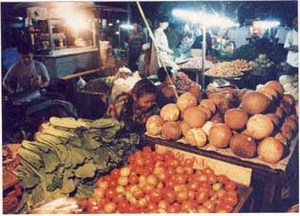Traditional Markets or Supermarkets
 For personal reasons, Rita, a mother of three, prefers shopping at the muddy-floored traditional market near her house than a “comfortable” hypermarket less than one kilometer away. The cheaper prices at the hypermarket or the mini-market opposite her housing complex in West Jakarta have also failed to lure her as an article in the Jakarta Post explains. Rita, in her 50s, continues to choose the wet market because it offers customer service which she doesn’t find with the modern retailers that have mushroomed in the city over the past decade.
For personal reasons, Rita, a mother of three, prefers shopping at the muddy-floored traditional market near her house than a “comfortable” hypermarket less than one kilometer away. The cheaper prices at the hypermarket or the mini-market opposite her housing complex in West Jakarta have also failed to lure her as an article in the Jakarta Post explains. Rita, in her 50s, continues to choose the wet market because it offers customer service which she doesn’t find with the modern retailers that have mushroomed in the city over the past decade.
“It is the sense of intimacy I feel every time I go shopping in the traditional market,
“The kind of feeling you wouldn’t get while shopping at a hypermarket or any other modern retailer.”
For Rita, shopping means more than just getting everything on a list and heading home. It involves her emotional needs.
“A housewife like me spends more time at home taking care of household chores. I have only a few friends to chat to about everything,” Rita said.
“Every time I go shopping at the (traditional) market, I am actually exercising my need to socialize with others. There I can chat with traders whom I know well, because I have frequented their shops for many years.”
She said that she talked openly with them but mainly about household matters such as the rising price of groceries, and of course, about children.
She makes friends not only with vendors but also with other housewives doing their grocery shopping.
“We have a community in the traditional market and it is part of my life,” she said.
This kind of loyal community with its intimate relationships has helped traditional markets survive amid fierce competition from modern retailers.
Unlike the regimented systems of modern retailers, the casual approach of market vendors allows for intimacy with customers.
At traditional markets, shoppers can sit and chat while haggling for cheaper prices.
“It is actually the bargaining process which creates a relationship between the vendors and the customers,” said Abu, who runs a small grocery shop at the Angke Market, North Jakarta.
“If you can accept the price they are willing to pay and they know you aren’t overcharging, they will become loyal customers … they stay loyal even when you get sick or when a relative dies,” he said.
Abu added allowing customers to pay for their purchases on credit also strengthened their relationship.
“This trust between us helps make customers more loyal and personable.”
However, it seems this intimacy is mainly appreciated by members of the older generation, like Rita who has shopped at traditional markets since she was a child, while younger people prioritize comfort.
“It is nice if you know the shop owners well, but I prefer shopping at supermarkets because they are cleaner and more comfortable,” said a woman in her late 20s.
The future may look bleak for traditional market vendors facing a younger generation that doesn’t appreciate the same intimacy their parents had.
“I am worried that the (traditional) market near my house will one day be replaced with a modern one. I will miss the intimacy,” said Rita.